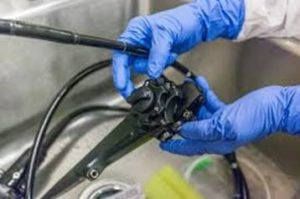 With all the protocols that endoscope techs and sterile processing staff must follow to properly high level disinfect every scope, flexible endoscopes can disappear into a black hole when they are needed most – only to pop up again when it is too late. There are several contributors to this inefficiency: long waiting periods in between staff hand-offs, excessive travel time to shuttle scopes from patient rooms to sterile processing and back, and then a time-consuming process to actually reprocess endoscopes. When all is said and done, a busy facility may take 6 to 10 hours or more to reprocess a single scope.
With all the protocols that endoscope techs and sterile processing staff must follow to properly high level disinfect every scope, flexible endoscopes can disappear into a black hole when they are needed most – only to pop up again when it is too late. There are several contributors to this inefficiency: long waiting periods in between staff hand-offs, excessive travel time to shuttle scopes from patient rooms to sterile processing and back, and then a time-consuming process to actually reprocess endoscopes. When all is said and done, a busy facility may take 6 to 10 hours or more to reprocess a single scope.
If Endoscopy or PeriOp is allowing delays to happen in the reprocessing cycle, they are risking patient safety and department profitability. If scopes are not turned around fast enough for use in the next procedure, patients may have to wait for scopes to become available before their procedure can begin. This introduces unnecessary patient risks into the department. The business risks of an inefficient reprocessing cycle are delayed or canceled cases. These often-avoidable situations result in financial harm to the department. Some hospitals may try to cover up for reprocessing inefficiencies by inflating the number of scopes that they own, which leads to its own financial issues.
With so many moving parts, it can be a virtual nightmare to sit down and analyze the bottlenecks that are creating these long reprocessing times. There’s the time to get the scope from the bedside to sterile processing, the time to get from sterile processing through the entire reprocessing cycle, and then the time to return a scope to clean storage. There are multiple runners transporting scopes around and multiple techs involved in the reprocessing process. So how can hospitals get their reprocessing times down from 6-10 hours to a more reasonable 3-4 hours, doubling throughput for their expensive scopes?
Managers must constantly monitor accurate and verifiable data to make sure that any bottlenecks in the reprocessing cycle are identified and systematically eliminated. Slow moving employees must be identified to make sure that the good performers are rewarded while the slower performers are given the opportunity to improve. Without this data, bottlenecks are likely to persist because benchmarks cannot be set, and measurements of performance cannot be adequately tracked.
However, obtaining the proper data to analyze the roadblocks to an efficient process has proven to be quite a challenge. This is where scope tracking systems, such as iRIScope from Mobile Aspects, can help deliver the necessary data. These systems manage the tracking and usage of an entire endoscope inventory, and include analyses of scope reprocessing efficiency based on timestamps automatically gathered by the system. Data can be reviewed and targets can be set and tracked to drive improvements to the scope reprocessing cycle. iRIScope also helps track down missing scopes by recording a real-time chain of custody, so missing scopes can be identified and tracked down immediately. iRIScope will also help manage all of the usage, reprocessing and repair details of your entire scope inventory, and will offer up actionable analytics on how to improve the management of your expensive scopes. Finally, built in patient safety features also minimize the risk from adverse health events caused by inadequately reprocessed scopes. Put these together and you can minimize the amount of time required to reprocess an endoscope while maintaining the highest reprocessing standards possible and safeguarding your patients.
